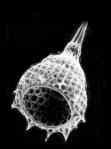|
|
INTRODUCTION & MORPHOLOGY
The Radiolaria is a subclass of protoctistan (single-celled) organisms of the class Sarcodina, which also includes the amoebas. Although radiolarians are closely related to the amoebas, radiolarians are distinguished by their intricate exoskeletons, or tests, which are formed by secretions. The secretions form a test which is usually made of silica and often has many spines extending outward. The outer shell or tests are generally spherical, symmetrical and sometimes several millimeters wide. However, radiolarian skeletons are extremely diverse, and they are the key feature on the basis of which this subclass is classified into smaller units (classes, superorders, orders, families, genera and species). Most species vary slightly from one subclass to another, and the skeletons of radiolarians are generally organized around spicules, or spines, which are sharp, dense outcroppings from the main skeletal mass. Formed from the fusion of many of these spines is the outermost skeleton, the cortical shell (the test). Connecting this shell to the many concentrically organized inner shells are bars or beams, which also serve to strengthen and support the entire structure. Within and extending into the many chambers created by this complex structure is the single cell of the organism. The siliceous bars or rods merge with each other leaving empty spaces between them - the pores. The perforated holes allow the pseudopods to extend for capturing food. The nucleus of the body is surrounded by chitin, and the outer cytoplasm contains vacuoles that help the radiolarian keep afloat in upper ocean waters. The radiolarian reproduces asexually. The most common reproduction occurs by cell division of the nucleus, the test splits apart and each half is replenished by the organism. When radiolarians die, their shells sink, forming the so-called radiolarian ooze of deep ocean floors that has formed many formations of sedimentary rock over the course of geological time.

Image from F. Cordey's The Rad Page (see Links)
Two superorders, Polycystina and Phaeodoria, are recognized within the Radiolaria. The two differ in many traits, but the greatest difference is among the chemical composition of their skeletons. Polycystina's shell are composed of amorphous silica (basically the composition of sand grains), while Phaeodoria's skeleton's silica is supported by a matrix of organic matter. This difference in chemical compostion causes major differences in preservation. Both groups sink to the ocean floor after death, however, dissolution of the organic matrix of Phaeodarian skeleton means only Polycystina radiolarians are well preserved. Thus, a thick layer of polycystine shells accumulate on the ocean floor.
|









